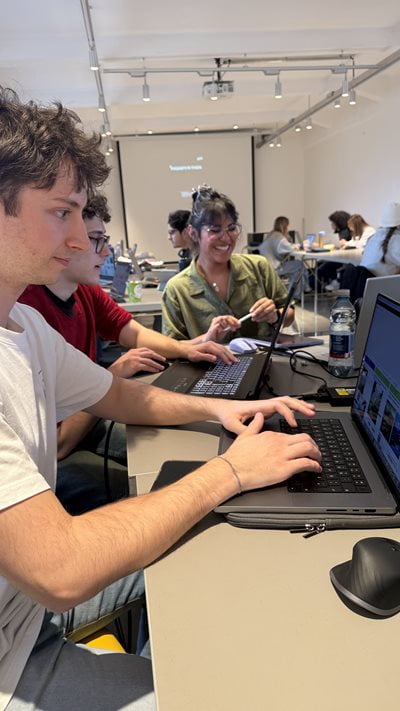Alpinestudio 2025: A Global Campus Merging Human and Artificial Design-Intelligence for Future-fit Cities

In a world grappling with the climate crisis and rapid urbanization, the Alpinestudio International Program, as part of CAPPA’s Study Abroad, Study Away (SASA) program, is proving that architectural education can be both globally connected and locally grounded. A joint initiative between the University of Texas at Arlington (UTA) and the University of Innsbruck in Austria, Alpinestudio is redefining how students learn to design for the future by embedding themselves in the present.
“Our goal in 2025 was to explore architecture as part of the Alpine ecosystem—culturally, environmentally, and spatially—while integrating emerging tools like generative AI,” said Dr. Oswald Jenewein, Assistant Professor at the School of Architecture. “We worked in close contact with city departments, professionals, and community members, grounding the studio in lived urban challenges.”
This year, enrollment in the program increased by 27 percent, indicating a growing interest in an approach that combines high-level design thinking with community engagement and ecological responsibility. At the heart of the studio’s exploration was the concept of the Superblock, an innovative urban design strategy that reclaims city streets for public life.
The Superblock, popularized initially in cities like Barcelona, prioritizes pedestrians and green space over car traffic. But in Innsbruck, students reimagined the model to suit the unique Alpine context. Collaborating with the city and drawing from environmental data, they developed strategies for cooling, stormwater management, and multispecies corridors.
“Emerging from this process was the Alpine Superblock: a typology that rethinks how architecture mediates between climate impacts, spatial organization, and collective urban life,” Dr. Jenewein noted. “It is one of the strongest examples of how novel urban design ideas can be meaningfully localized.”
Students also connected their work to broader movements in ecological urbanism during a site visit to Vienna University of Technology (TU Wein), emphasizing the cross-institutional and international nature of the program.
Alpinestudio is not only a transatlantic collaboration between institutions—it’s an example of how architecture is evolving as an interdisciplinary pool of knowledge. Students and faculty from Austria and the U.S. worked side by side in joint studios, developing proposals that reflect a deep understanding of cultural context, environmental urgency, and technical innovation.

Sample Student Proposals
“Collaboration is the foundation of contemporary practice,” said Dr. Jenewein. “Through our Building Futures lecture series and direct field engagement, we connect the studio to the world beyond the university. This prepares students to work not only across scales but across disciplines and cultures. That, to me, is the future of architectural education.”
In a time when cities are increasingly vulnerable to flooding, heat, and biodiversity loss, the projects developed by Alpinestudio students demonstrate architecture’s potential as a force for resilience and regeneration. Student proposals focused on water-sensitive design, ecological restoration, and social space-making, developed in collaboration with engineers, urban planners, and local stakeholders.
“These were not just speculative ideas,” Dr. Jenewein emphasized. “They were thoughtful, situated proposals that demonstrate how design can play a role in building climate resilience and civic well-being.”
One of the defining features of the 2025 studio was the thoughtful integration of generative AI into the design process. Far from being a crutch, AI served as a collaborator, helping students with drawing, modeling, mapping, and pushing conceptual boundaries to develop conceptually rich and socially grounded ideas.
“The students used AI not as a shortcut but as a collaborator,” said Dr. Jenewein. “What impressed me most was their ability to ask questions that opened new ways of perception and impact.”
For Dr. Jenewein, the emergence of AI in architectural education is a moment of reflection, not just experimentation. “AI is changing how we design, but it doesn’t change why we design. That remains our responsibility as architects and educators.”
As the Alpinestudio continues to grow in scope and recognition, it offers a hopeful vision for what architecture can become when it is rooted in collaboration, driven by the people, curiosity, and committed to ecological and social futures.
In a world of increasingly complex challenges, the 2025 cohort reminds us that design is not just about form—it’s about relationships: between people, environments, and the technologies that shape both.
Related to the Alpinestudio International Program
Prompt-a-thon Workshop


As part of the Future Cities seminar, the Prompt-a-thon Workshop brought together 30 participants over three days, moving from the initial concept to the final presentation. This novel pedagogical approach synthesized human and artificial intelligence, inviting students to explore how generative tools can expand architectural thinking. The final projects reimagined architecture not as an object, but as an agent, capable of responding to the urgency of a transforming climate. The outcome was a set of speculative visions for future-fit cities in the Alps, merging creativity, technology, and critical reflection.
Alpine Bootcamp


The Alpine Bootcamp is a two-day immersive experience focused on spatial awareness and human perception in extreme terrain. Set at Sattelberg, on the border between Austria and Italy, the boot camp included orientation walks, night navigation, risk assessment, and the exploration of igloo structures, transforming the Alpine environment into a site of architectural discovery.
Students engaged with the landscape through movement, observation, and real-time decision-making. The experience drew on vernacular Alpine architecture to examine how form, material, and climate coalesce in site-responsive design. As a pedagogical model, the bootcamp positioned architecture as a place-related practice, grounded in context as a driver for design.